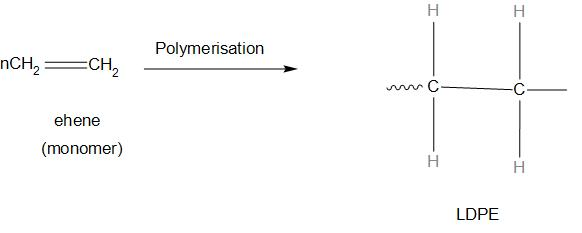
Explain with example, branched and linear polymers.
Answer
578.4k+ views
Hint: Polymers are made up of long, repeating chains of molecules. These have different properties depending on the type of molecules that are bonded and the way in which they are bonded.
Complete answer:
- Let’s first discuss about branched polymers:
- branched polymers have side chains or we can say that these have branches growing out from the main chain.
- During polymerization, the branches result from side reactions.
- It is generally found that the monomers with two or more end groups support branching.
- In branched polymer, the branches should comprise a minimum of one complete monomer unit.
- The common example of branched polymers is low-density polyethylene that is (LDPE) . It has wide applications ranging from plastic bags, textiles, containers, to coatings for various packaging materials.
-There is reduced packing efficiency in branched chains due to which these display lower density.
- The length of the branches differentiates between the short or the long branched polymers. Long branches are found to have comb-like or we can say star-shaped structures.
- let’s see an example of this:

- Let’s discuss about Linear polymer:
- In linear polymers there are the repeating units present which are joined together in a single flexible chain at end to end.
- Generally, linear polymers are more rigid in nature.
-Basically, linear polymers are made from monomers with one end group.
- Three are physical attractions present that keep the polymeric chains together. The attractions present in this are the Vander Waal forces that keep the chains together.
- There are some of the common examples of linear polymers that are, polystyrene, polyamides, PVC, polyethylene etc.
- let’s see an example of this:

Note:
- When polymers are cut, manipulated or heated these may be toxic. It is found that polymers and their by- products release dangerous vapours and dust when heated.
Complete answer:
- Let’s first discuss about branched polymers:
- branched polymers have side chains or we can say that these have branches growing out from the main chain.
- During polymerization, the branches result from side reactions.
- It is generally found that the monomers with two or more end groups support branching.
- In branched polymer, the branches should comprise a minimum of one complete monomer unit.
- The common example of branched polymers is low-density polyethylene that is (LDPE) . It has wide applications ranging from plastic bags, textiles, containers, to coatings for various packaging materials.
-There is reduced packing efficiency in branched chains due to which these display lower density.
- The length of the branches differentiates between the short or the long branched polymers. Long branches are found to have comb-like or we can say star-shaped structures.
- let’s see an example of this:

- Let’s discuss about Linear polymer:
- In linear polymers there are the repeating units present which are joined together in a single flexible chain at end to end.
- Generally, linear polymers are more rigid in nature.
-Basically, linear polymers are made from monomers with one end group.
- Three are physical attractions present that keep the polymeric chains together. The attractions present in this are the Vander Waal forces that keep the chains together.
- There are some of the common examples of linear polymers that are, polystyrene, polyamides, PVC, polyethylene etc.
- let’s see an example of this:

Note:
- When polymers are cut, manipulated or heated these may be toxic. It is found that polymers and their by- products release dangerous vapours and dust when heated.
Recently Updated Pages
Why are manures considered better than fertilizers class 11 biology CBSE

Find the coordinates of the midpoint of the line segment class 11 maths CBSE

Distinguish between static friction limiting friction class 11 physics CBSE

The Chairman of the constituent Assembly was A Jawaharlal class 11 social science CBSE

The first National Commission on Labour NCL submitted class 11 social science CBSE

Number of all subshell of n + l 7 is A 4 B 5 C 6 D class 11 chemistry CBSE

Trending doubts
What is meant by exothermic and endothermic reactions class 11 chemistry CBSE

10 examples of friction in our daily life

One Metric ton is equal to kg A 10000 B 1000 C 100 class 11 physics CBSE

1 Quintal is equal to a 110 kg b 10 kg c 100kg d 1000 class 11 physics CBSE

Difference Between Prokaryotic Cells and Eukaryotic Cells

What are Quantum numbers Explain the quantum number class 11 chemistry CBSE




